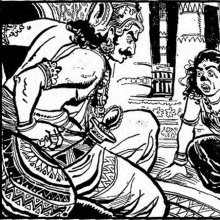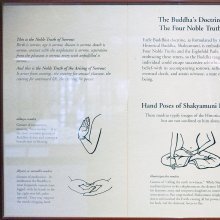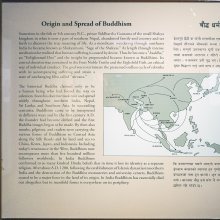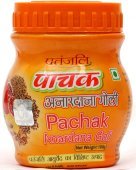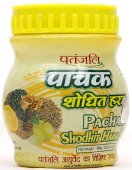Suffering: 2 definitions
Introduction:
Suffering means something in Hinduism, Sanskrit, the history of ancient India. If you want to know the exact meaning, history, etymology or English translation of this term then check out the descriptions on this page. Add your comment or reference to a book if you want to contribute to this summary article.
Images (photo gallery)
In Hinduism
Natyashastra (theatrics and dramaturgy)
Source: Shodhganga: Elements of Art and Architecture in the Trtiyakhanda of the Visnudharmottarapurana (natya)Suffering (due to cold, old age, etc.) is associated with Vidhuta: one of the “seven movements of the head” (in Sanskrit Dramas), as conveyed through Āṅgikābhinaya: one of the four divisions of Abhinaya or “ways to convey or represent one’s emotion to others”, according to the Nāṭyaśāstra and the Viṣṇudharmottarapurāṇa, an ancient Sanskrit text which (being encyclopedic in nature) deals with a variety of cultural topics such as arts, architecture, music, grammar and astronomy.—The āṅgikābhinaya includes the histrionic representation of the limbs which is simply known as physical gestures. In the Viṣṇudharmottarapurāṇa, seven types of movements of the head are recorded. The Vidhuta movement expresses suffering by cold or old age or because of the consumption of liquor.

Natyashastra (नाट्यशास्त्र, nāṭyaśāstra) refers to both the ancient Indian tradition (shastra) of performing arts, (natya—theatrics, drama, dance, music), as well as the name of a Sanskrit work dealing with these subjects. It also teaches the rules for composing Dramatic plays (nataka), construction and performance of Theater, and Poetic works (kavya).
India history and geography
Source: Singhi Jain Series: Ratnaprabha-suri’s Kuvalayamala-katha (history)1) Suffering (of the world) was investigated by those pursuing the spiritual life in the Hermitages (or Ashrams) of ancient India, as vividly depicted in the Kathās (narrative poems) such as Uddyotanasūri in his 8th-century Kuvalayamālā (a Prakrit Campū, similar to Kāvya poetry).—Page 87.20-28: Here is a vivid description of the intellectual and spiritual life in the Aśrama of a Jaina Muni. Uddyotanasūri gives a list of twenty-one methods of study and discussions and approaches to the tenets of religion and philosophy, [e.g., speaking against the suffering of the world] [...]. Also see the description of the hermitage of Divākara Mitra described by Bāṇa in the Harṣacarita.
2) Suffering (from many kinds of diseases, etc) represents a scene of human life commonly depicted on the Saṃsāracakra paintings in ancient India, according to the Kuvalayamālā.—Page 185.21 f.: Here follows a description of a printed scroll illustrating the Jaina conception of saṃsāracakra. [...] The saṃsāra-cakra illustrated the three worlds of hell, human world and the world of gods. [For example:] People suffering from many kinds of diseases like fever, pain and burning, and lying on their cots and meeting their deaths, to gather their mourning servants, wives and friends

The history of India traces the identification of countries, villages, towns and other regions of India, as well as mythology, zoology, royal dynasties, rulers, tribes, local festivities and traditions and regional languages. Ancient India enjoyed religious freedom and encourages the path of Dharma, a concept common to Buddhism, Hinduism, and Jainism.
See also (Relevant definitions)
Ends with: Enduring suffering, Truth of Suffering.
Full-text (+2724): Duhkha, Dukkha, Four Noble Truths, Kayaklesha, Anukampa, Pida, Gatalakshmika, Samtapa, Shoka, Sukhanganem, Sharkarin, Gharmarta, Himelu, Arditin, Arshasa, Bhaya, Adhyatmikaduhkha, Daru, Kshutpipasa, Klishitavat.
Relevant text
Search found 462 books and stories containing Suffering; (plurals include: Sufferings). You can also click to the full overview containing English textual excerpts. Below are direct links for the most relevant articles:
The Great Chariot (by Longchenpa)
Part 1 - The brief teaching of suffering < [A. The general explanation of the nature of suffering]
Part 3 - Meditation on Compassion < [G. How to meditate]
3d) The human realm < [Part 3 - The main divisions]
Buddha-nature (as Depicted in the Lankavatara-sutra) (by Nguyen Dac Sy)
2. The Buddha-nature: Solution to Individual and Social Problems < [Conclusion]
3.3. Cleansing the Twofold Group of Passions < [Chapter 4 - The Thought of Buddha-Nature in the Laṅkāvatārasūtra]
General Introduction < [Introduction]
Maha Prajnaparamita Sastra (by Gelongma Karma Migme Chödrön)
II. The concept of suffering (duḥkha-saṃjñā) < [Chapter XXXVII - The Ten Concepts]
The Śalyatvena-sūtra (Sallattena-sutta) < [Chapter XXXVII - The Ten Concepts]
Part 2 - Enduring outer and inner sufferings and the afflictions < [Chapter XXV - Patience Toward the Dharma]
Bhakti-rasamrta-sindhu (by Śrīla Rūpa Gosvāmī)
Verse 2.5.104 < [Part 5 - Permanent Ecstatic Mood (sthāyī-bhāva)]
Verse 3.2.134 < [Part 2 - Affection and Service (dāsya-rasa)]
Verse 1.2.203 < [Part 2 - Devotional Service in Practice (sādhana-bhakti)]
Philosophy of Charaka-samhita (by Asokan. G)
Liberation (mokṣa) as the ultimate moral end < [Chapter 8 - Ethics]
Concept of liberation in other philosophical systems < [Chapter 8 - Ethics]
Theory of karma < [Chapter 8 - Ethics]
Guhyagarbha Tantra (with Commentary) (by Gyurme Dorje)
Text 15.4 (Commentary) < [Chapter 15 (Text and Commentary)]
Text 5.5 (Commentary) < [Chapter 5 (text and commentary)]
Commentary 3.2: The Recognition of Rudra < [Chapter 15 (Text and Commentary)]
Related products
(+14 more products available)
